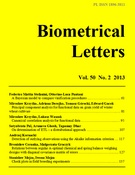
Biometrical Letters Vol. 50(2), 2013, pp. 137-149


This paper deals with the problems of selection in the early stages of a breeding program. During the improvement process, it is not possible to use an experimental design that satisfies the requirement of replicating all the treatments, because of the large number of genotypes involved, the small amount of seed and the low availability of resources. Hence unreplicated designs are used. To control the real or potential heterogeneity of experimental units, control (check) plots are arranged in the trial.
There are many methods of using the information resulting from check plots. All of the usually applied adjusting methods for unreplicated experiments are appropriate for some specific structure of soil fertility. Their disadvantage is the fact that, before and also after the experiment, we usually do not know what a kind of soil structure is present in the experiment. Hence we cannot say which of the existing methods is appropriate for a given experimental situation. The method of inference presented below avoids this disadvantage. It is always appropriate, because of the fact that a trend of soil variability is identified and estimated. In the paper the main tool used to explore this information will be based on a response surface methodology. To begin with we will try to identify a response surface characterizing the experimental environments. We assume that observed yield (or another trait) results directly from two components, one of them due to soil fertility and the other due to the genotype effect. This means that difference between observed yield and forecast can be treated as the estimate of a genotype effect. The obtained response surface will then be used to adjust the observations for genotypes. Finally, the data so adjusted are used for inferences concerning the next stage of the breeding program. The theoretical considerations are illustrated with an example involving yields of spring barley.
There are many methods of using the information resulting from check plots. All of the usually applied adjusting methods for unreplicated experiments are appropriate for some specific structure of soil fertility. Their disadvantage is the fact that, before and also after the experiment, we usually do not know what a kind of soil structure is present in the experiment. Hence we cannot say which of the existing methods is appropriate for a given experimental situation. The method of inference presented below avoids this disadvantage. It is always appropriate, because of the fact that a trend of soil variability is identified and estimated. In the paper the main tool used to explore this information will be based on a response surface methodology. To begin with we will try to identify a response surface characterizing the experimental environments. We assume that observed yield (or another trait) results directly from two components, one of them due to soil fertility and the other due to the genotype effect. This means that difference between observed yield and forecast can be treated as the estimate of a genotype effect. The obtained response surface will then be used to adjust the observations for genotypes. Finally, the data so adjusted are used for inferences concerning the next stage of the breeding program. The theoretical considerations are illustrated with an example involving yields of spring barley.

breeding field experiments, check plots, phenotypic selection, unreplicated experiments

